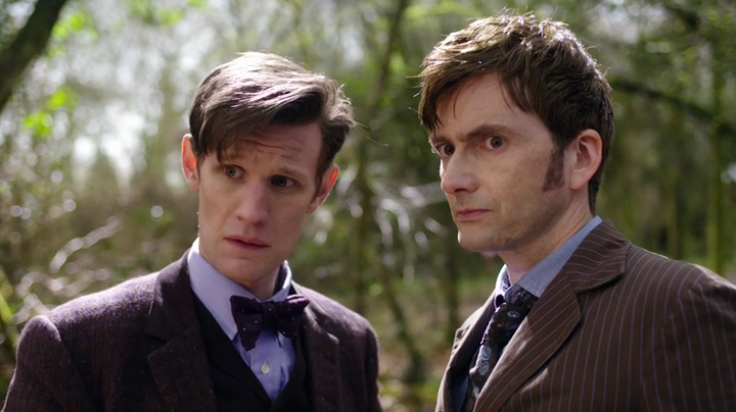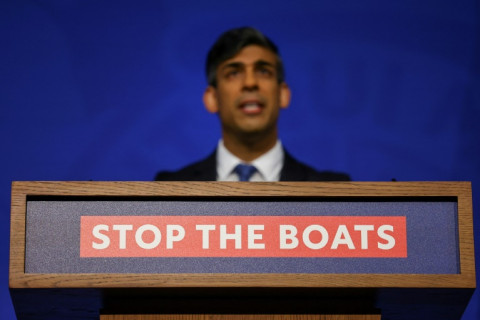Doctor Who 50th Anniversary Special Review – The Day of the Doctor

We were promised an event, and boy did we get it. Shifting time periods, multiple Doctors, old foes and some surprising revelations; Steven Moffat's expertly written The Day of the Doctor could not have been a greater love letter to fans of Doctor Who on its 50<sup>th anniversary, an episode that triumphantly celebrated the show's past while providing an intriguing glimpse of its future.
First came the many loving references. The use of the iconic original opening from 1963; the black and white feedback rippling across the screen as Delia Derbyshire's haunting electronic score played sent shivers down the spine. The parts of the Doctor's history, from Gallifrey to the Time War, Unit, Tom Baker's scarf, Tom Baker himself! It was a truly dazzling array of moments that heightened the general revelry of the episode rather than detracting from the story.
Time Lord Art
And what a story it was. Moffat outdid even his most complex narratives here to shape a 75-minute episode that incorporated a modern day visit to the National Art Gallery, Elizabethan England and the last day of Gallifrey into a tightly packed story that dexterously interwove the three plot threads into a beautiful tapestry.
Or should I say oil painting. I'll admit to watching the episode in regular 2D, so cannot testify to what the extra dimension would have been like, but those 3D paintings, a nifty invention by the Time Lords, seemed to be the only real use for the format.
Because despite the event drama billing and big screen outing, what was most surprising about the episode was how spectacle and action was eschewed in favour of dialogue and character drama. Yes we had the completely unnecessary scene where the Tardis was flown in to Trafalgar Square, and a few shots of the Daleks razing Gallifrey, but fittingly the 50<sup>th anniversary special managed to contain the bombast to focus on the Doctor himself, and who exactly he was.
The Three Doctors
This came in the form of not one, not two, but three Doctors, as incumbent Matt Smith was joined by his predecessor David Tennant and the mysterious War Doctor played by John Hurt. Despite former Doctors teaming up in the classic series, this is the first time in New Who (discounting Children in Need special Time Crash) that multiple incarnations of the Time Lord have interacted on screen. It was thrilling to watch, especially the way John Hurt's Doctor looks down on the two older versions as immature boys, and Moffat made sure that their bickering did not overshadow the story.
It was great to see Tennant's Doctor, the one most readily associated with the revival of the show, back on screen, but his role in the 50<sup>th certainly appeared the weakest aspect. Maybe it was because his interactions with Queen Elizabeth (Joanna Page), constantly mistaking her for a Zygon before marrying her, weren't particularly funny, but it was mainly the fact that compared to Matt Smith's Doctor being the protagonist of the episode and John Hurt's War Doctor the antagonist, he often felt like the forgotten middle child of the piece.
Because no question this was John Hurt's episode. Crash landing in to Who canon as the forgotten Doctor, his gruff take on the Time Lord served as the bridge between the classic and modern versions of the show, with his decision to destroy all Time Lords and Daleks the mysterious gap that has existed in Doctor Who history ever since the show returned.
An Unearthly 60s Child
When Russell T Davies gave us Christopher Eccleston's Doctor as 'the last of the Time Lords' in 2005, it was part designed to streamline the camp baggage that would have made the show impenetrable to a new generation of viewers, but also to bring the Doctor in line with other superheroes who were given a dark makeover in the 1980s and 1990s.
But this was a show born from the destruction of the Second World War. The Doctor's nemeses the Daleks are clearly symbolic of Nazi Germany, and here the decision by Hurt's Doctor on whether to detonate his planet has clear echoes of Hiroshima and Nagasaki. By having Hurt's Doctor given the dilemma of whether to kill everyone on Gallifrey (with some stellar scenes between him and Billie Piper's Bad Wolf), Moffat tapped in to the central theme that has always ran throughout the show's history - who exactly is the Doctor?
The answer emphatically given is one that the 1960s generation that spawned the show would have approved of; that the Doctor is the saviour of lives, not the other way round. The three Doctors use their combined genius to freeze Gallifrey in time and thus save it from extinction, with the scene of all of the Doctor's incarnations (including the eyes of next Doctor Peter Capaldi), working together to time-lock Gallifrey, an inspired moment that unified all versions throughout the show's history.
Gallifrey Falls No More
As was that final exchange between Matt Smith and the Curator, cryptically played by Tom Baker. How he comes to be there remains unknown, I'm sure it's all very timey-wimey (as Hurt's Doctor would hate to hear), but after answering who the Doctor is, their conversation points the current incarnation of the Time Lord to where he is heading, and that is to try and find his home, Gallifrey.
But before all that is the Christmas Special, featuring a whole array of the Doctor's villains, as well as the fall of the eleventh (or should we now say twelfth?). If the emotional wallop of seeing Matt Smith depart and Peter Capaldi take the reins of the Tardis is anything as good as The Day of the Doctor, we're in for a real treat.
READ:
Doctor Who Review Roundup: 50<sup>th Anniversary Special Goes Back to Basics
Doctor Who 50<sup>th Anniversary - Is Showing the Special in cinemas a Mistake?
© Copyright IBTimes 2024. All rights reserved.






